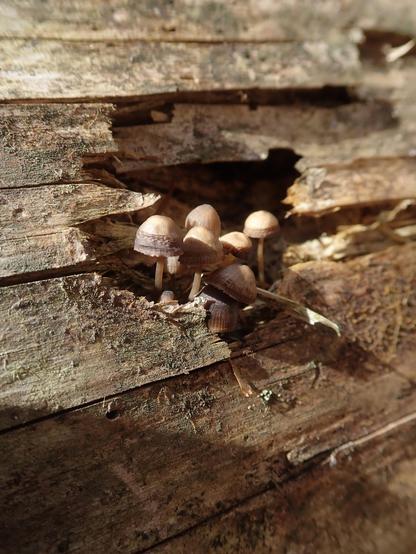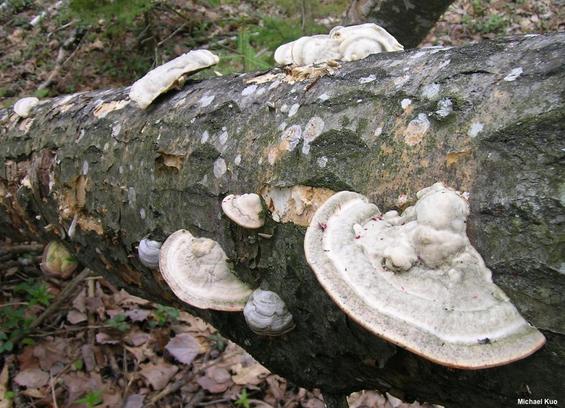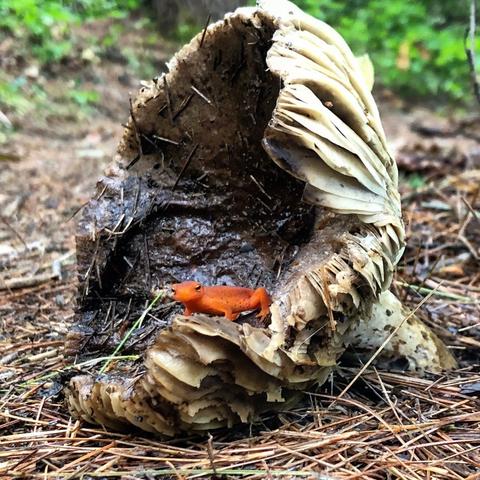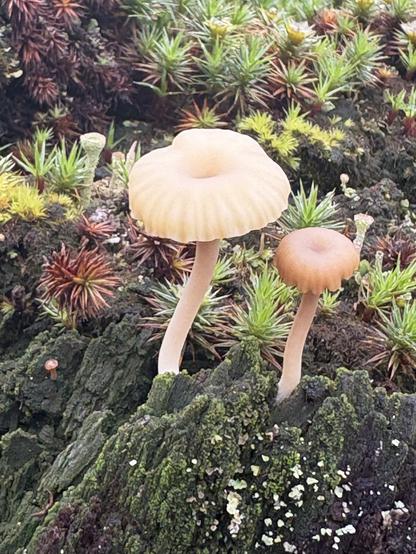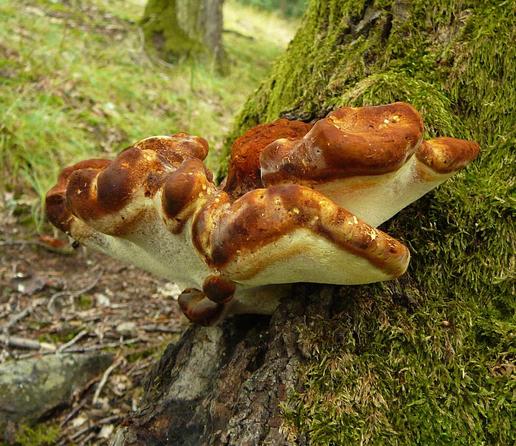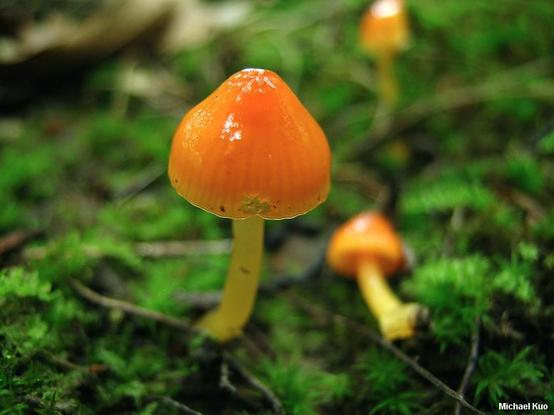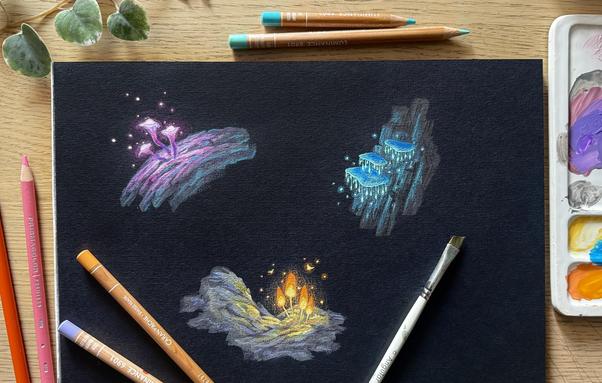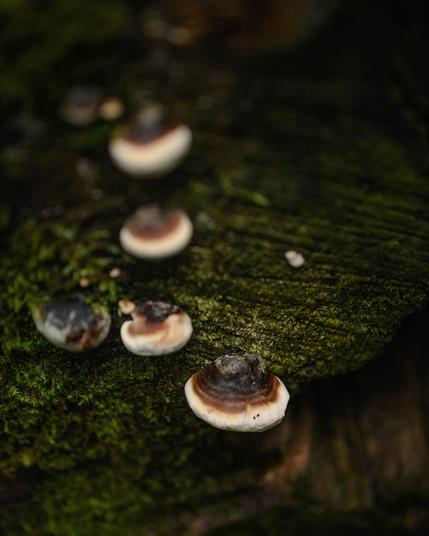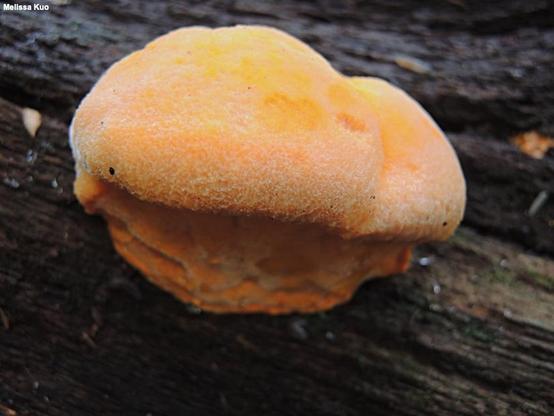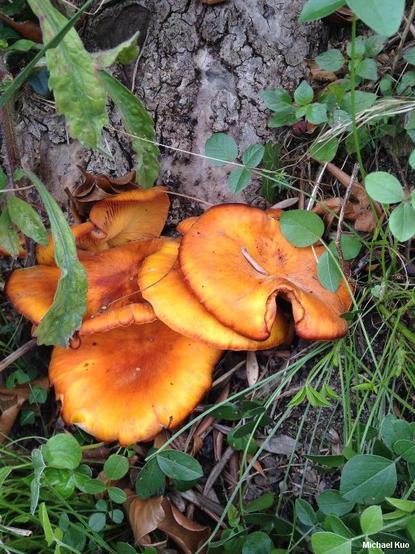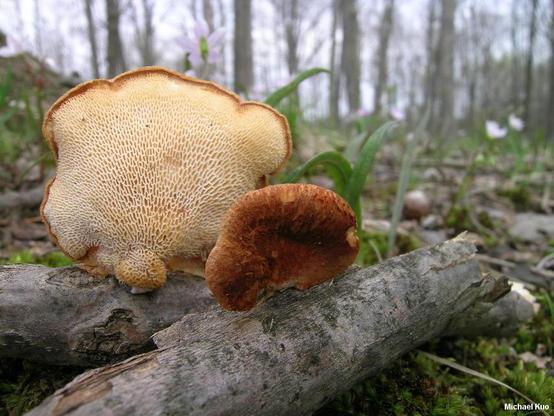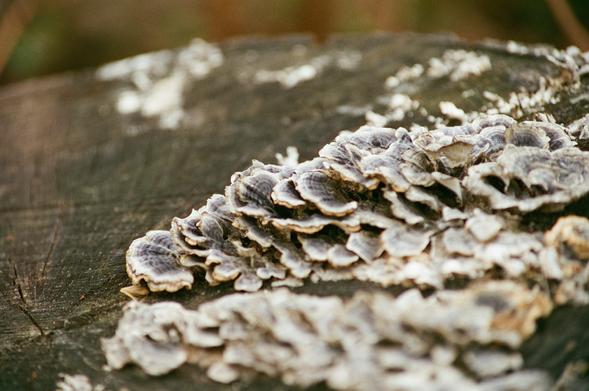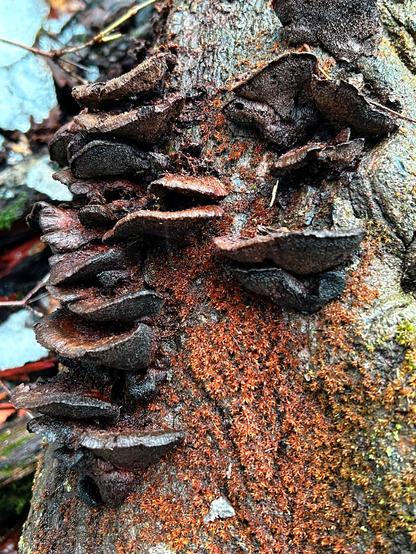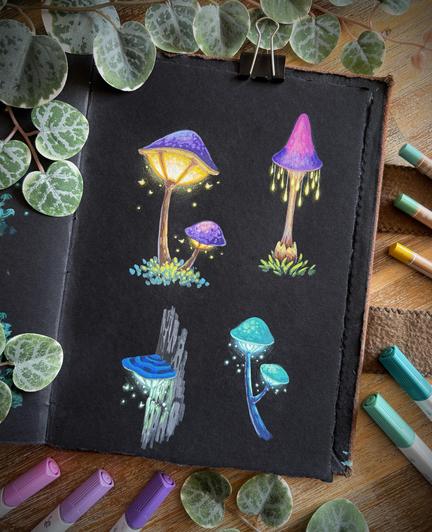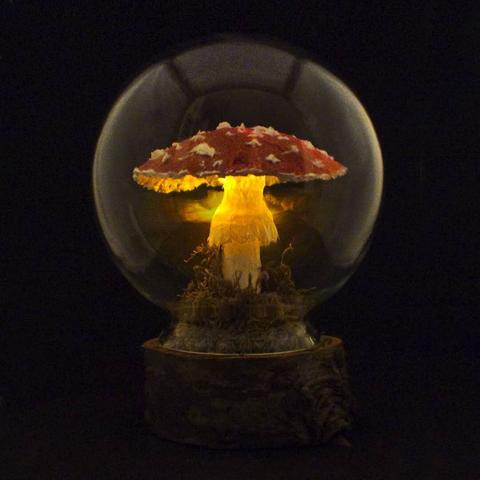Recent searches
Search options
#mushtodon
Trametes gibbosa
https://www.mushroomexpert.com/Trametes_gibbosa.html
Ecology: Saprobic on the deadwood of hardwoods; annual; causing a white rot of the sapwood; growing alone or gregariously on logs and stumps; spring through fall; originally described from Europe (Persoon 1795); widely distributed in Eurasia; in North America distributed from the Great Plains eastward, and in the Pacific Northwest. The illustrated and described collections are from Illinois, Michigan, North Carolina, and Ohio.
Cap: 4-20 cm across; 2.5-9 cm deep; 1.5-5 cm thick; semicircular or kidney-shaped; convex to planoconvex; dry; vaguely or distinctly zoned with tomentose and bald zones; whitish to grayish or brownish (sometimes green in places due to algae); lumpy; the margin often yellowish to brownish or brown when fresh.
Pore Surface: White to pale brownish; usually featuring slot-like pores (1-2 per mm) with thick pore walls, but occasionally with maze-like pores; tubes 2-15 mm deep; bruising yellow to pinkish or brownish—or not bruising.
Stem: Absent, or present as a prominent bump at the point of attachment to the substrate or, less often, as a stubby lateral structure with a surface like that of the cap.
Flesh: White; very tough and leathery; not changing when sliced.
Odor and Taste: Odor usually strong and fragrant when fresh, but sometimes not distinctive; taste slightly bitter, or not distinctive.
Chemical Reactions: KOH yellow to orange on flesh.
Spore Print: Whitish to faintly yellowish.
Microscopic Features: Spores 4-5 x 1.5-2.5 m; cylindric to long-ellipsoid; smooth; hyaline in KOH; inamyloid. Cystidia not found. Setae not found. Hyphal system trimitic: generative hyphae 2.5-5 m wide, thin-walled, with clamp connections; skeletal hyphae 5-7.5 m wide, thick-walled, aseptate; binding hyphae 2.5-5 m wide, thick-walled, aseptate, branching frequently.
Not much in the way of spring mushrooms in my area but I did spot a couple showy Lichenomphalia and a shy pixie cup in the background. #fungi #mushtodon #yyj #victoriabc
We have hashtags like #mushtodon and #FungiFriday but what about one for polypores? I was thinking #polyporn, seems like nothing could possibly go wrong with that.
Hygrocybe glutinipes
https://www.mushroomexpert.com/Hygrocybe_glutinipes.html
Ecology: Precise ecological role uncertain (see Lodge and collaborators, 2013); appearing in woods, often on mossy ridgetops; growing scattered or gregariously; spring; North American distribution uncertain. The illustrated and described collections are from Illinois.
Cap: 5-30 mm across; convex, bell shaped, or nearly hemispheric, becoming broadly convex, broadly bell shaped, or nearly flat; slimy; bald; bright orange to bright reddish orange, fading to paler orange; the margin sometimes faintly lined.
Gills: Narrowly to broadly attached to the stem; close or nearly distant; orange or pale pastel orange; short-gills frequent.
Stem: 20-40 mm long; 2-6 mm thick; equal; slimy; bald; colored like the cap, or paler.
Flesh: Colored like the cap, or paler; thin.
Odor and Taste: Not distinctive.
Chemical Reactions: KOH on cap erasing orange pigment.
Spore Print: White.
Microscopic Features: Spores 6-9 x 3.5-5 ; smooth; ellipsoid; hyaline and uniguttulate in KOH; inamyloid. Basidia to 45 long; 4-sterigmate. Hymenial cystidia absent. Gill tissue parallel. Pileipellis an ixotrichoderm of elements 2-4 wide.
Glowing mushroom goodness painted during this month’s Patreon stream~
The replay is available for Adepts and the Inner Circle: https://www.patreon.com/posts/march-25-paint-125505929?utm_medium=clipboard_copy&utm_source=copyLink&utm_campaign=postshare_creator&utm_content=join_link
You still got until the end of the day to get your 1st month in the Apprentice or Adept tier at 15% off with the code SPRINGFEVER
Hapalopilus croceus
https://www.mushroomexpert.com/Hapalopilus_croceus.html
Ecology: Saprobic and parasitic on the wood of oaks; growing alone or in small groups; causing a white rot of the heartwood; summer and fall; widely distributed east of the Great Plains. The illustrated and described collection is from Ohio.
Cap: 4-10 cm across; 3-5 cm deep; semicircular to kidney-shaped; convex; moist; finely fuzzy; golden orange.
Pore Surface: Bright golden orange; not bruising; with 2-3 angular pores per mm; tubes to 2-4 mm deep.
Stem: Absent.
Flesh: Thick; zoned with zones of golden orange, pastel orange, and brownish; fairly soft.
Chemical Reactions: KOH instantly dark purple on all parts.
Microscopic Features: Spores 7-8 x 4-5 m; ellipsoid; smooth; hyaline in KOH; inamyloid. Hyphal system monomitic; hyphae 2-4 m wide, smooth or encrusted, hyaline or brownish orange, thin-walled, septate, clamped at septa, often agglutinated with brownish to orangish encrusting material.
Omphalotus olearius
https://www.mushroomexpert.com/Omphalotus_olearius.html
Ecology: Saprobic; growing in large clusters on the stumps or buried roots of hardwoods, especially olive trees; late summer and fall; originally described from France (de Candolle, 1815); distribnuted in central and southern Europe. The illustrated and described collection is from Italy.
Cap: 4-12 cm; at first broadly convex, but soon becoming shallowly to moderately depressed; not usually featuring a central bump; bald; dry or slightly greasy; bright brownish orange to yellowish orange—or in some collections reddish orange or nearly brown; the margin slightly inrolled when young.
Gills: Running down the stem; close; orange; with many short-gills; luminescent when fresh.
Stem: 3.5-9 cm long; 1-2 cm thick; tapering to base; solid; bald; pale orange to orange.
Flesh: Pale orange; unchanging when sliced.
Odor: Not distinctive.
Spore Print Whitish.
Microscopic Features: Spores 5-7 x 4-6 m; sublacrymoid to subglobose; smooth; hyaline to yellowish in KOH. Cystidia not found. Pileipellis a cutis of clamped, cylindric elements 5-10 m wide; green in KOH. Refractive elements not found in the pileipellis and subpellis.
REFERENCES: (de Candolle, 1815) Singer, 1948. (Fries, 1821; Phillips, 1981; Moser, 1983; Nonis, 2001; Kirchmair & Pöder, 2002; Kirchmair et al., 2002; Kirchmair et al., 2004; Gminder & Böhning, 2017.) Herb. Kuo 10161402.
Neofavolus alveolaris
https://www.mushroomexpert.com/Neofavolus_alveolaris.html
Ecology: Saprobic on recently-dead sticks and small logs (occasionally on living branches) of hardwoods, when bark is still attached; causing a white rot; growing alone, scattered, or gregariously; typically first appearing in late spring, but frequently found in summer and fall; widely distributed and common east of the Rocky Mountains. The illustrated and described collections are from Illinois and Québec.
Fruiting Body: 2-7 cm across; fan-shaped, semicircular, or kidney shaped; upper surface orange to orangish when fresh and young, fading with age to yellowish or nearly white, radially fibrillose to scaly (at least at first), dry, bald; typically featuring a short and stubby lateral stem, but occasionally with a centrally located and more substantial stem (in which case the cap is round, rather than kidney shaped); pore surface descending the stem, whitish to pale orangish; pores to 1 mm wide and 2 mm long, diamond-shaped or "honeycombed," usually radially arranged; flesh to 2 mm thick, white, tough, unchanging when sliced.
Odor and Taste: Odor not distinctive; taste not distinctive, or slightly bitter.
Chemical Reactions: KOH dull olive on fresh cap; negative on flesh.
Spore Print: White.
Microscopic Features: Spores 8-14 x 2.5-4 ; subcylindric; smooth; hyaline in KOH. Basidia 4-spored. Pileipellis a cutis of somewhat agglutinated, hyaline to brownish, clamped elements 2-3 wide. Hyphal system dimitic.
Aged alder bracket (𝘐𝘯𝘰𝘯𝘰𝘵𝘶𝘴 𝘳𝘢𝘥𝘪𝘢𝘵𝘶𝘴 or 𝘔𝘦𝘯𝘴𝘶𝘭𝘢𝘳𝘪𝘢 𝘳𝘢𝘥𝘪𝘢𝘵𝘢), from the Wiley Trails.
I took the picture from an angle as if the tree were still standing, but the rotted out trunk had broken in the wind and lay horizontally across our path.
A page of mushroom lamps~
My patrons already got to see the first one a few days ago, plus a couple process pictures and musings on this marker set.
This is from 6 January 2019
I'm planning on making a series of this Amanita muscaria. It's going to be slightly different, with another glass dome. Can't find the same one currently. But I think it should be good, no matter what glass dome protects it.
This one became a night light for twins!
There was a giveaway in my archive on Instagram between this and the previous post - but I decided against posting that one here too. It doesn't do much for my archive and it would probably confuse the heck out of anyone here. So I skipped that post and went to the next one.
It does make me wonder though - are giveaways appreciated here too?
#art #CreativeToots #DutchArtist #OriginalArt #Artwork #mosstodon #LichenSubscribe #MastoArt #mushtodon #mushrooms
Wait, what?
There's a mushroom bot?
hands u these cystidia :3
(more tomorrow but I am 2eepy4this, goodnight internet creatures)
A thought I've had a few times lately: my current setup is far from sufficient for this, but in the future I think it might be fun to try livestreaming a bit of microscopy. Would anyone actually wanna watch such a thing?
I'm not saying it would happen anytime soon (or ever), but I may start looking into what upgrades it would take to make a livestream feasible if there's any interest. Poll below if you think that sounds neat ig
and as a thank you for reading this whole thing, check the replies for a low-quality cystidia pic 
Did you know you can also find process pictures for this fairy tree on my Patreon? I regularly post insights into my process and techniques there, as well as peeks at doodles and sketches I show nowhere else, and all that for just 2€/mo in the Novice tier!
(the higher tiers get many many more perks still )
And ofc this original is still up for adoption!
Make it yours: https://lindenshieldarts.com/products/mixed-media-original-fairy-arch
#MastoArt #TraditionalArt
#Gouache #ColoredPencil #MixedMedia #FantasyArt #Mushtodon #FediGiftShop


